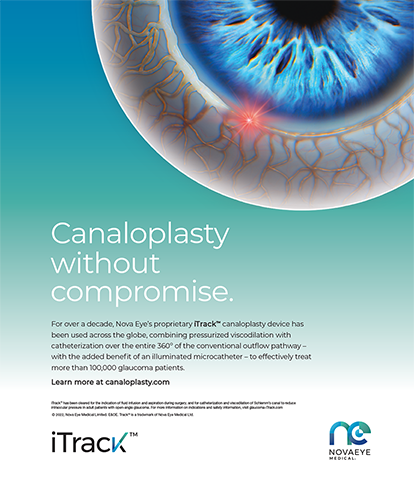
Dry eye disease (DED) was defined by the Tear Film and Ocular Surface Society Dry Eye Workshop II (TFOS DEWS II) as “a multifactorial disease of the ocular surface characterized by a loss of homeostasis of the tear film, accompanied by ocular symptoms in which tear film instability and hyperosmolarity, ocular surface inflammation and damage, and neurosensory abnormalities play etiologic roles.”1
Despite the multifactorial nature of DED, this disease can be chronically self-perpetuating through a vicious cycle,2 wherein epithelial damage secondary to the hyperosmolar state causes exposure and chronic stimulation of corneal nerve endings. Reduction in corneal sensitivity in turn promotes neurogenic stress, contributing to the impairment of ocular surface homoeostasis and the release of proinflammatory factors, which are then responsible for greater damage to the ocular surface and to the gland itself.3
Conventional therapies have involved the use of artificial tears to increase ocular surface moisture and lubrication and topical antiinflammatory and immunosuppressive therapies to address the chronic inflammatory nature of this condition.
Recently, regenerative strategies involving growth factors have emerged, resulting in significant advances in the management of DED, particularly in patients whose disease has been refractory to traditional therapies.
This article discusses five growth factor–related therapies that have a role in the treatment of DED.
No. 1: Autologous serum tears. Autologous serum (AS) tears was one of the first applications of growth factors to the eye, dating back to 1975, for treatment of ocular alkali injuries.4 The first successful use of AS in patients with DED was described in 1984.5
Preparation involves collecting the patient’s own blood. The serum is the liquid portion of the blood that is collected after it clots. The blood is then centrifuged, and the resulting supernatant, or serum, is prepared for use as eyedrops.6 Typically, a 20% dilution is used, with applications ranging from t.i.d. to every 2 hours while awake. The TFOS DEWS II Management and Therapy Report stated that 60% to 80% of DED patients showed a positive response to AS therapy.7
AS contains numerous substances that also exist in normal tears, including growth factors such as transforming growth factor beta, platelet-derived growth factors, epidermal growth factor, nerve growth factor, and insulin-like growth factor 1; neurotrophic factors, including substance P; cytokines; bacteriostatic factors (lactoferrin, lysozyme, and immunoglobulins); fibronectin, and vitamins A and E. As such, AS not only serves lubricating and antiinflammatory functions, but it also has regenerative properties for healing the ocular surface.
AS, which is reported to have a high concentration of nerve growth factor, requires frequent and continuous use to produce an effect. Hence, additional factors may be involved.
No. 2: Other blood products. Healing of the ocular surface can also be achieved with other blood products rich in growth factors. These include allogenic serum and platelet-rich plasma, which are discussed in the sidebar above.
No. 3: Cryopreserved amniotic membrane. Self-retaining cryopreserved amniotic membrane, such as the Prokera corneal bandage devices (BioTissue), can be beneficial for patients with DED who are not responding to conventional therapies. These products, rich in nerve growth factors, were demonstrated by John and colleagues to promote corneal nerve regeneration, as evidenced on confocal microscopy at 1 and 3 months after application, along with significant improvement in the signs and symptoms of DED.8 A single placement of Prokera Slim (BioTissue) for 3 to 5 days significantly increased subbasal corneal nerve density while reducing the mean DEWS score from 2.9 ±0.3 at baseline to 1.1 ±0.3 at 1 month and 1.0 at 3 months in the treatment group (P < .001). This result was consistent with the notion that a decrease of subbasal nerve density is correlated with severity of DED.
BLOOD PRODUCTS RICH IN GROWTH FACTORS
Allogenic Serum
May be considered when a patient’s own blood is unavailable or unsuitable, particularly in patients with immune-mediated pathologies that have large inflammatory and systemic components.1
Platelet-Rich Plasma
Can be obtained by centrifugation, generating a plasma fraction with a platelet concentration higher than that in the circulating blood.2 Platelets can be artificially activated to release their contents housed in alpha granules, rich in a large pool of proteins and growth factors that are involved in the wound-healing process of the corneal and conjunctival surface.3
1. Stenwall PA, Bergström M, Seiron P, et al. Improving the anti-inflammatory effect of serum eye drops using allogeneic serum permissive for regulatory T cell induction. Acta Ophthalmol. 2015;93:654-657.
2. Wang HL, Avila G. Platelet rich plasma: myth or reality? Eur J Dent. 2007;1(4):192-194.
3. Alio JL, Rodriguez AE, WróbelDudzińska D. Eye platelet-rich plasma in the treatment of ocular surface disorders. Curr Opin Ophthalmol. 2015;26(4):325-332.
No. 4: Recombinant human nerve growth factor. A first-in-class recombinant human nerve growth factor (rhNGF) that successfully treats neurotrophic keratitis, cenegermin-bkbj ophthalmic solution 0.002% for topical ophthalmic use (Oxervate, Dompé), is being investigated in a phase 2b trial to evaluate its effects in patients with moderate to severe DED. rhNGF has been shown previously to act through specific high- and low-affinity receptors on the lacrimal gland, epithelium, conjunctiva, endothelial cells, and corneal nerves.9 It is thought to work by supporting epithelial survival and maintenance, tear production, and corneal innervation.
Patients who have stage 1, 2, or 3 neurotrophic keratitis as defined by the Mackie classification system are eligible for FDA-approved treatment using this unique drug. Some patients with severe DED, particularly those with diffuse punctate keratitis, when evaluated with corneal sensitivity testing, may currently qualify as having a stage 1 neurotrophic keratitis and would therefore be eligible for use of cenegermin, given the FDA guidelines.
No. 5: Combinations. The therapies discussed here can be used in combination with one another. The use of one does not preclude considering adding another if a patient has not achieved an adequate response. In fact, these therapies often have synergistic effects.
CONCLUSION
We still have a lot to learn about the role of growth factor in DED. The current and emerging advances in these regenerative strategies are welcome and especially beneficial for patients who are refractory to traditional therapies.
1. Craig JP, Nichols KK, Akpek EK, et al. TFOS DEWS II Definition and Classification Report. Ocul Surf. 2017;15(3):276-283.
2. Bron AJ, de Paiva CS, Chauhan SK, et al. TFOS DEWS II pathophysiology report [published correction appears in Ocul Surf. 2019 Oct;17(4):842]. Ocul Surf. 2017;15(3):438-510.
3. Stevenson W, Chauhan SK, Dana R. Dry eye disease: an immune-mediated ocular surface disorder. Arch Ophthalmol. 2012;130(1):90-100.
4. Ralph RA, Doane MG, Dohlman CH. Clinical experience with a mobile ocular perfusion pump. Arch Ophthalmol. 1975;93(10):1039-1043.
5. Fox RI, Chan R, Michelson JB, Belmont JB, Michelson PE. Beneficial effect of artificial tears made with autologous serum in patients with keratoconjunctivitis sicca. Arthritis Rheum. 1984;27(4):459-461.
6. Pan Q, Angelina A, Marrone M, Stark WJ, Akpek EK. Autologous serum eye drops for dry eye. Cochrane Database Syst Rev. 2017;2(2):CD009327. Published 2017 Feb 28.
7. Jones L, Downie LE, Korb D, et al. TFOS DEWS II Management and Therapy Report. Ocul Surf. 2017;15(3):575-628.
8. John T, Tighe S, Sheha H, et al. Corneal nerve regeneration after self-retained cryopreserved amniotic membrane in dry eye disease. J Ophthalmol. 2017;2017:6404918.
9. Charters L. Treating dry eye with recombinant human nerve growth factor. Ophthalmology Times. https://www.ophthalmologytimes.com/view/allergic-conjunctivitis-molecule-debut. Accessed July 16, 2020.




